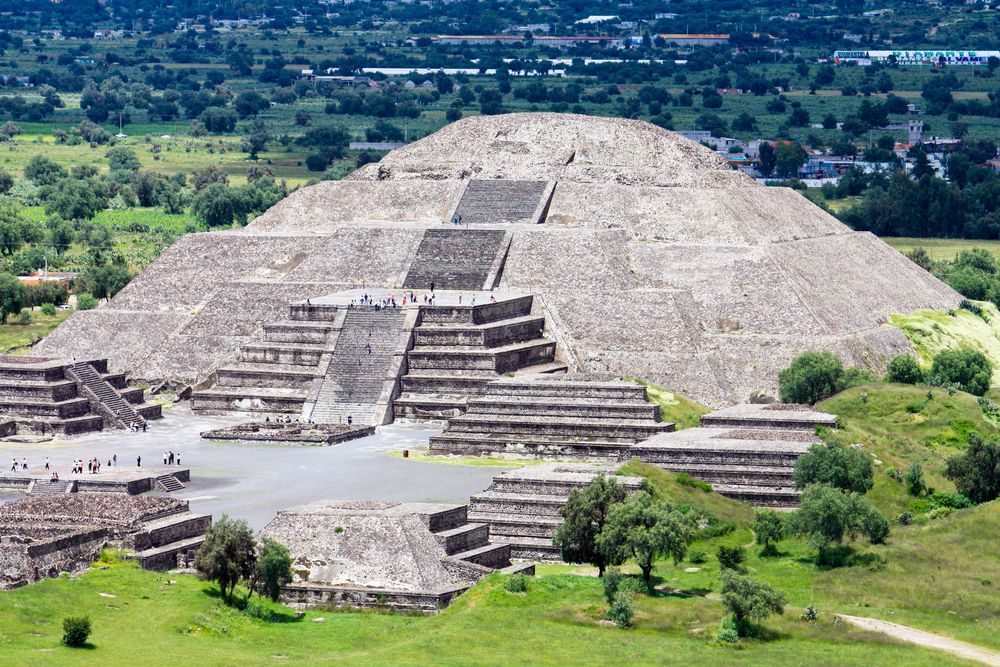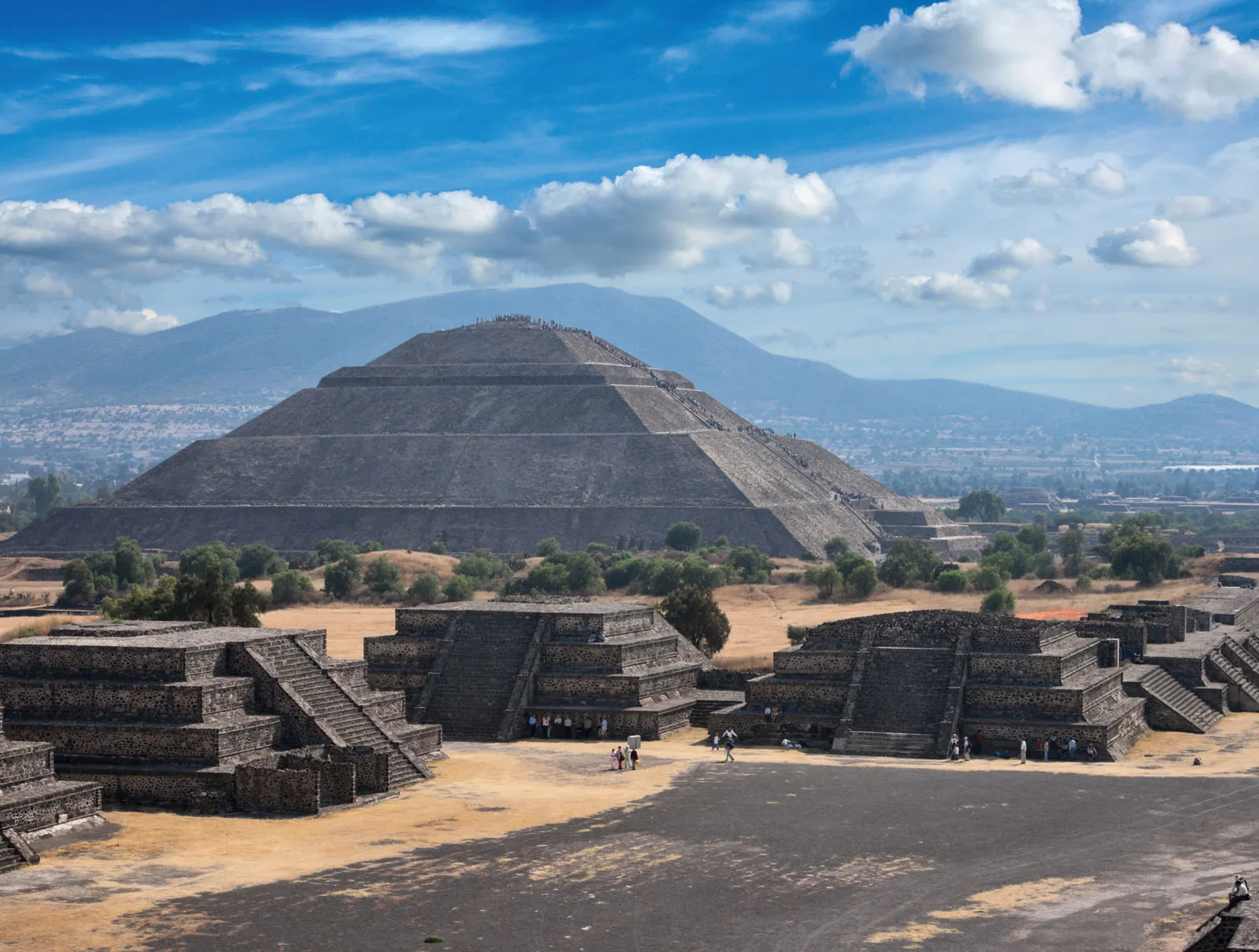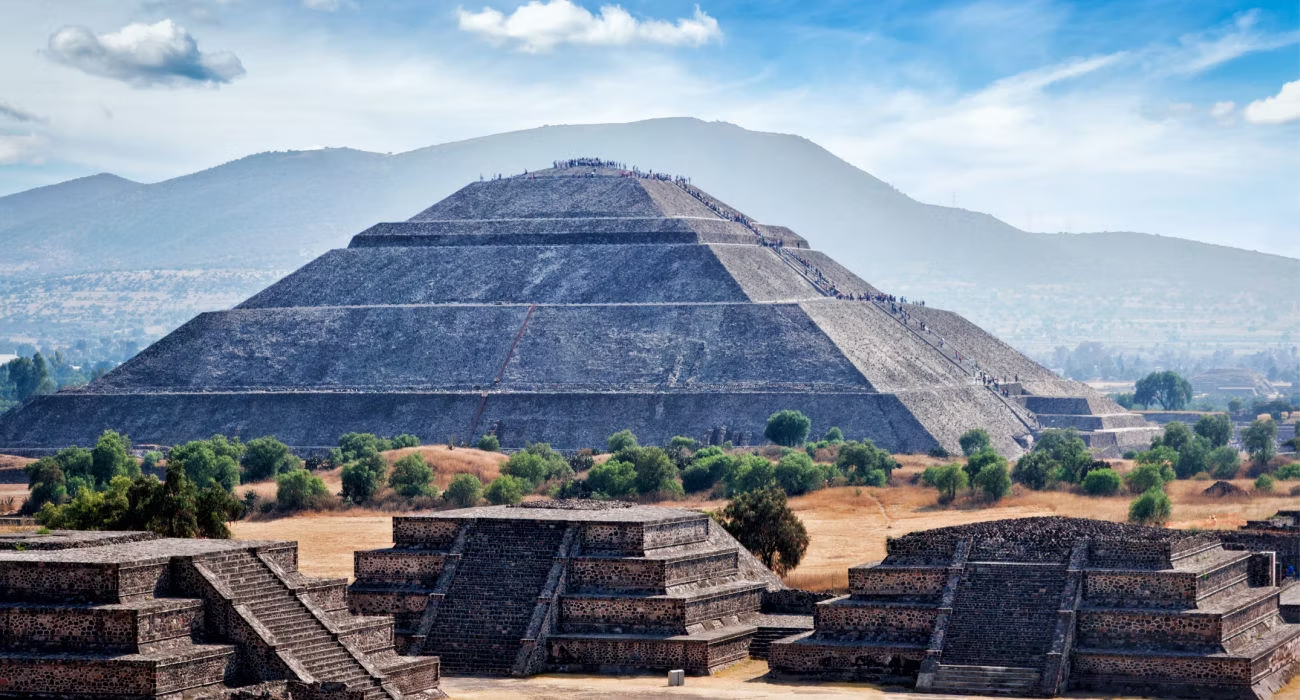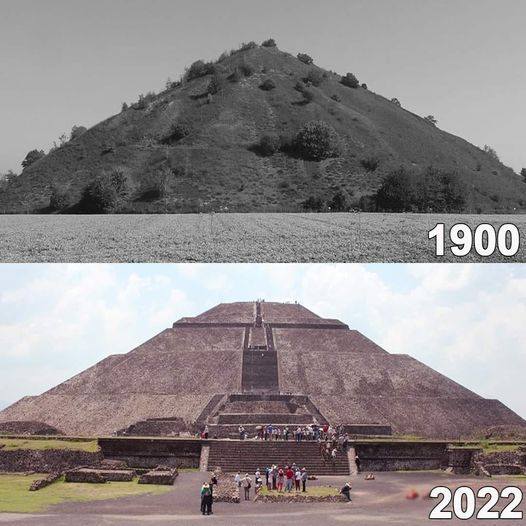Teotihuacan Pyramid in Mexico City in 1900 and in 2022. The 1900 view must have looked like a random mountain, until the excavations and clean-up began.
Teotihuacan is an ancient Mesoamerican city situated 30 miles (50 km) northeast of present-day Mexico City. It was recognized as a UNESCO World Heritage Site in 1987. The city was settled as early as 400 B.C. and rose to prominence, becoming the most powerful and influential city in the region by 400 A.D. By the time the Aztecs discovered the city in the 1400s and named it Teotihuacan (meaning “the place where the gods were created”), it had already been abandoned for centuries. Much about Teotihuacan’s origins, history, and culture remains a mystery.

Teotihuacan Pyramids
Teotihuacan (also written Teotihuacán) is organized in a grid layout covering approximately 8 square miles (20 square kilometers). It contains around 2,000 single-story apartment compounds, along with various pyramids, plazas, temples, and palaces of nobles and priests.
The city’s primary structures are linked by the Avenue of the Dead (or Miccaotli in the Aztec language Nahuatl). This 130-foot- (40-meter-) wide, 1.5-mile- (2.4-km-) long road is oriented slightly east (15.5 degrees) of true north and points directly at the nearby sacred peak of Cerro Gordo, an extinct volcano.

Several large, significant structures are found in Teotihuacan, including the Pyramid of the Moon, the Pyramid of the Sun, the Ciudadela (“Citadel”), and the Temple of Quetzalcoatl (the Feathered Serpent).
Pyramid of the Moon
Situated at the northern end of the Avenue of the Dead and facing south, the Pyramid of the Moon is surrounded by smaller pyramids and platforms. It stands at 140 feet (43 meters) high with a base measuring 426 by 511 feet (130 by 156 meters), making it the second largest structure in Teotihuacan.

Pyramid of the Sun
Less than half a mile south of the Pyramid of the Moon stands the largest structure in Teotihuacan, the Pyramid of the Sun. Facing west, this pyramid rises to 216 feet (66 meters) with a base measuring approximately 720 by 760 feet (220 by 230 meters).
The Ciudadela
Located at the southern end of the Avenue of the Dead, the Ciudadela encompasses a 38-acre (15-hectare) courtyard containing multiple elite residential complexes. It is dominated by the Temple of Quetzalcoatl, a truncated pyramid adorned with numerous stone heads of the Feathered Serpent deity.

Who Built Teotihuacan?
The builders of the ancient city remain unknown. Initially, scholars believed that the Toltec civilization, based largely on colonial period texts, might have built Teotihuacan. However, the Toltec culture (900-1150 A.D.) thrived long after Teotihuacan had peaked. Other theories suggest the Totonacs, a tribe from the east, might have built and inhabited the city. Another possibility is that immigrants, displaced by a volcanic eruption, flooded into the Teotihuacan valley and either built or expanded the city. Teotihuacan exhibits features of various cultures, including the Maya, Mixtec, and Zapotec. The city was founded as early as 400 B.C., with its largest structures completed around 300 A.D. It is believed to have reached its zenith about 100 years later, with a population as high as 200,000 people.
Teotihuacan Religion
Little is known about the language, politics, culture, and religion of the Teotihuacan people. They had a glyph-based written language, likely limited to dates and names. The city’s art and architecture indicate a polytheistic society, with the Great Goddess of Teotihuacan, depicted as a spider goddess, being the primary deity. Other deities included Quetzalcoatl (a vegetation god whose meaning evolved in subsequent civilizations), the rain god Tlaloc, and the god of spring Xipe Totec, among others. Teotihuacan priests conducted ritual sacrifices of animals and people to these gods.
In 1989, researchers found 18 sacrificial victims buried in a pit south of the Temple of Quetzalcoatl. They later discovered that about 200 more victims were sacrificed during the temple’s construction in the early 3rd century A.D. Many of these sacrifices were male warriors in military attire, while others were young women or males of relatively high social status. In 2004, evidence of sacrifices at the Pyramid of the Moon suggested the site was used to celebrate state power and militarism. These sacrifices included 12 people with their hands bound, 10 of whom were decapitated. Other sacrifices at the pyramid included five canines (wolves or coyotes), three felines (jaguar or puma), and 13 birds (mainly eagles)—animals symbolizing warriors.
Teotihuacan Influence
Artifacts from Teotihuacan and sites across Mexico suggest it was a wealthy trade metropolis in its prime. The city exported fine obsidian tools, including spear and dart heads, and had a monopoly on obsidian trade, with the most important deposit in Mesoamerica located nearby. Ceramics, such as elaborately decorated pottery and other luxury goods, were also highly prized exports. Other goods traded likely included cotton, cacao, and exotic feathers and shells. Local harvests included beans, avocados, peppers, and squash, and city farmers raised chickens and turkeys. Teotihuacan’s art and architectural styles are found widely throughout Mesoamerica, indicating its far-reaching influence.




